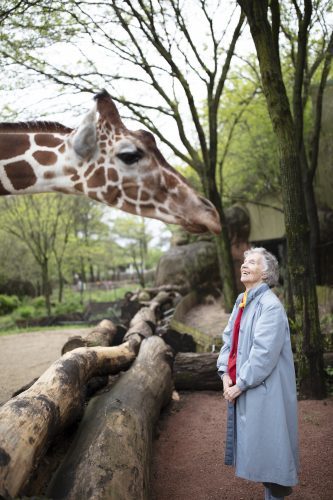
Anne Innis Dagg returns to where it all started in The Woman Who Loves Giraffes
THE WOMAN WHO LOVES GIRAFFES (Alison Reid, 2019)
Quad Cinema
34 West 13th St. between Fifth & Sixth Aves.
Opens Friday, January 10
212-255-2243
quadcinema.com
Before Jane Goodall went to Tanzania to study chimpanzees and Dian Fossey headed to Rwanda to study mountain gorillas, Canadian biologist Anne Innis Dagg was in South Africa, studying giraffes. Her delightful yet infuriating story is told in Alison Reid’s The Woman Who Loves Giraffes, which opens January 10 at the Quad, where the eighty-six-year-old Dagg will participate in Q&As with Reid at six screenings on Friday and Saturday. Dagg fell in love with giraffes when she was three and first saw them at the Brookfield Zoo in Chicago. In 1956, when she was twenty-three, she set off for the Fleur de Lys ranch near Kruger National Park. That trip was quite a victory, based on a bit of subterfuge; in her application to manager Alexander Matthew, she didn’t identify herself as female because she had been previously rejected by many other locations that claimed that “Africa is no place for a young woman.”
She spent a year taking meticulous notes on the social and sexual behavior of giraffes, essentially making up her methods as she went. “No one had ever really studied an African animal in the wild, or pretty well any animal in the wild,” she says in the film. “So I was sort of breaking ground without realizing it.” But when she returned to Toronto, Dagg, the daughter of a university professor father and an economic historian mother, both of whom were widely published writers, was met with a frightening amount of misogyny in the scientific and education communities; she failed to get tenure or other prominent teaching positions, which led her to become a feminist activist in the 1970s. “She ran into the old boys’ network and I think it destroyed her career,” says former University of Guelph professor Sandy Middleton, the only member of the tenure committee that supported Dagg. All these years later, the head of the committee, former dean Keith Ronald, still adamantly defends his decision against Dagg.
It wasn’t until 2010 that Dagg, who uses “giraffe” as both a singular and a plural, reentered the giraffe fold, mainly because of women such as San Francisco Zoo curator Amy Phelps, who says, “I was the little girl that that woman was a hero for, and so it was really important to me that we be able to find her. . . . We were searching for Anne because we really didn’t know if she was alive.” Reid follows Dagg as she is celebrated at the Giraffe Care Conference in Arizona, then goes back to Africa for the first time since the mid-1950s to attend a Giraffe Indaba near Fleur de Lys, bringing her daughter, Mary, with her. Reid and editors Mike Munn and Caroline Christie heartwarmingly intercut footage Dagg took in 1956, photographs and 16mm film, with new scenes of her in the same exact places. Reid also includes narration of Dagg’s extensive letters and writings — she’s written more than twenty books, most importantly The Giraffe: Its Biology, Behavior, and Ecology, considered the bible on the subject — with the voices of Tatiana Maslany as Dagg, Victor Garber as Matthew, David Chinchilla as Anne’s husband, Ian, and Lindsay Leese as Dagg’s mother, Mary Quayle Innis.
The previously little-known Dagg — who in 1965 stumped the To Tell the Truth panel, a clip of which begins the documentary — revels in her newfound semicelebrity and has delved right back into her research. “I always wanted to be a scientist,” she says. The documentary has an inconsistent pace and treacly music, but it’s a thrill watching Dagg look back at her past as she heads into the future; it’s also hard not to think about what could have been had she not been thwarted time and time again because of her gender.